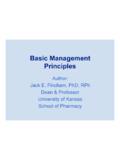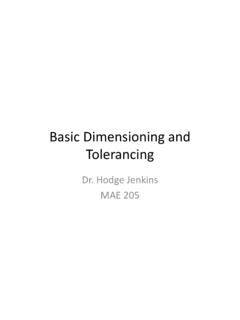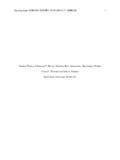Transcription of Time Response of Second Order Systems - Mercer University
1 Time Response of Second Order Systemsfrequency natural theratio damping ess dimensionl 2)2(/)/()/()(:only first term he Consider t)()()()()()()(0)0(')())0()(()())0(')0() (()()()()(22020220002222==+++=+++=++++++ =++=++= = =nnnnssysMKsMBsyMBssYKBsMssFKBsMsyBMssYO rsFByMsysKYsBsYsYMsyLetsKYyssYBsFysysYsM tKydttdyBtfdttydM damped)y (criticall real and roots same 1 Ifdamped)(under complex are roots1 Ifreal are roots1 If11:roots twohas 2equation sticcharacteri The2;222122 = < > = + =++== nnnnnnnjsjsssKMBMKW here 112cos)(tan,1)sin(11)(: Response stepunit For == =+ =tetyntn)sin(11)( + = tetyntn 12cos,1 = = Step Response : whereShowing the step Response with different dampingcoefficientsStandard Performance measures Performance measures are usually defined in terms of the step Response of aPerformance measures are usually defined in terms of the step Response of asystem as below:system as below.
2 Swiftness of the Response is measured by Swiftness of the Response is measured by rise time , rise time , andand peak time peak time For For underdampedunderdamped system, the Rise time (0-100% rise time) is useful, system, the Rise time (0-100% rise time) is useful, For For overdamped overdamped Systems , the the Peak time is not defined, and the (10-90 % risesystems, the the Peak time is not defined, and the (10-90 % risetime) is normally usedtime) is normally used Peak time:Peak time: Steady-state error:Steady-state error: Settling time:Settling time: Percent ofPercent of Overshoot: Overshoot: is the peak value is the peak value is the final value is the final value of the Response of the responsepTrTpT% =ssesTrTr1 TptMfv Percentage overshoot measures the closeness of thePercentage overshoot measures the closeness of theresponse to the desired to the desired Response .
3 The The settling time settling time is the time required for the is the time required for thesystem to settle within a certain percentage of thesystem to settle within a certain percentage of theinput amplitude. For Second For Second Order Order system, system, we seek we seek for for which thewhich theresponse remains within Response remains within 2% of 2% of the the final value. Thisfinal value. Thisoccurs approximately whenoccurs approximately when:: Hence the settling Hence the settling time time is defined is defined as 4 time 4 time sTnssnTTTesn 44 :Therefore4 = < Explicit relations for andExplicit relations for and : : To find we can either differentiate y(t) directly orTo find we can either differentiate y(t) directly orindirectly through indirectly through LaplaceLaplace Transform of y (t).
4 Transform of y (t):tpMpT221/1 :overshoot Percentage1:is responsepeak The1 =+= ==eOPeMTtpnnppTImpulse Response of the Second Order system: LaplaceLaplace transform of the unit impulse is R(s)=1 transform of the unit impulse is R(s)=1 Impulse Response :Impulse Response : Transient Response for the impulse function, which is simply is theTransient Response for the impulse function, which is simply is thederivative of the Response to the unit step:derivative of the Response to the unit step:)2()(222nnnsssY ++=)sin()(tetyntnn = Responses and pole locationsResponses and pole locations Time Responses and Pole Locations:Time Responses and Pole Locations: are the poles.
5 Are the poles. Therefore the settling time is inversely proportional to the real part of the the settling time is inversely proportional to the real part of the 44= 22212211:roots twohas 2equation sticcharacteri The = + =++nnnnnnjsjsss21,ss











